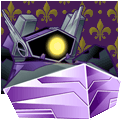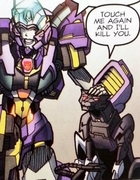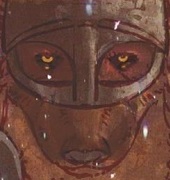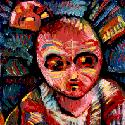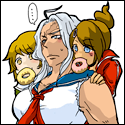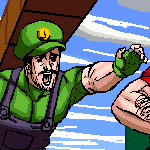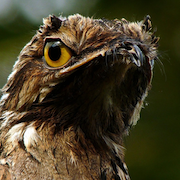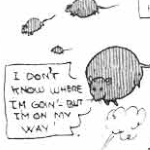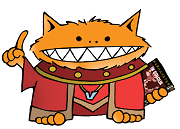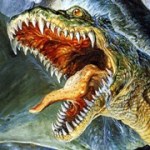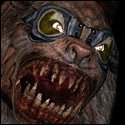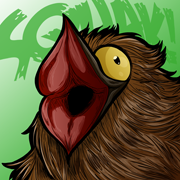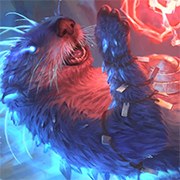|
Yeah I should be clear I think the Wasp Tower is not very well thought through, but could be fixed. Don't know that I would when there's other ones ready to roll right out of the box, of course. But my point was mostly that the hosts targeting rich people to use their resources makes a lot of sense given how many of them are defined by being survivors who figured out a niche, where the rest of them got werewolfed into nothing. The game does a good job of selling werewolves as the spirit cops that even their truly grotesque enemies have reason to fear.
|
|
|
|

|
| # ? Apr 17, 2024 12:11 |
|
Nessus posted:They're probably going back to the decadent rich person cult well both for the same broad zeitgeist reasons why people are always bitching that every game doesn't have a "build communism and purge the kulaks" option, as well as to avoid the "cult = marginalized group" perspective a lot of fiction has. Thinking about it more, I'm reminded of how the anarchy in J.G. Ballard's High Rise, where the architect-owner is bribing the constable that checks in on a routine patrol to look the other way despite the building's infrastructure in several systematic collapse and the residents robbing, raping and murdering each other.
|
|
|
|
If anyone was wondering where the magic furries went, I haven't abandoned World Tree, I've just been caught up in a trifecta of 'Too hot to focus on writing + Starting a new job + My monitor loving EXPLODED' but I'm still working on it as best I can
|
|
|
|
Look, sometimes you have to spend weeks investigating subtle clues and implications; other times you ask a dude on the street and he points at the giant glowing highrise with the perpetual storm above it that nobody ever enters or comes out of except for this one crazy rich lady who makes a weird buzzing noise.
|
|
|
|
Chernobyl Peace Prize posted:Well, the write-up does say that the cops are largely inactive and the city is lovely and corrupt, so it's more like "who's going to notice if people in this specific spot are going missing, compared to everywhere else?" Yeah, Detroit was also the first city I thought of. "There's this building that's dark and people go missing when they go there!" "You say that as if it's just the one."
|
|
|
|
Detroit isn't that dangerous, it's mostly just too big and heavily class divided and has no public transit and a small population due to a ton of factors. I live in Detroit.
|
|
|
Night10194 posted:Detroit isn't that dangerous, it's mostly just too big and heavily class divided and has no public transit and a small population due to a ton of factors.
|
|
|
|
|
Detroit pops up a lot as people's go to locale for Werewolf.
|
|
|
|
Night10194 posted:Detroit isn't that dangerous, it's mostly just too big and heavily class divided and has no public transit and a small population due to a ton of factors.
|
|
|
|
Wasp Tower is probably the best intro story I've seen so far for a K9: Spirit Police style game. It can be done fairly creepily, it could be used to introduce a lot of concepts to a new group, and if the group ends up really liking the wasps as bad guys, there are splinter cults you can follow up with. There's two or three sessions of great story there. I'd even be tempted to run it with a horror movie cold open, giving the players a generic handyman character sheet and sending them in for maintenance, only to be horrifically eaten.
|
|
|
|
yeah, Wasp Tower could use some work but it functions as a 'here, rip and tear this poo poo' since people are gonna pick up werewolf to rip and tear, so let 'em do so every so often.
|
|
|
|
Yeah, to clarify, when I say the woofs would look at this one and go 'Well, we know what to do', that wasn't a negative.
|
|
|
|
Night10194 posted:Alternately, you let your woofs relax from all the intractable problems they can't solve with murder by allowing them a nice, relaxing dungeon crawl through a skyscraper infested with hideous wasp-men and aberrations until they fight a failed radio wasp god on the roof. I'd be more inclined to demolish the whole tower, there's nothing here to save. Bring the radio wasp god down to you.
|
|
|
|
H4: Throne of Bloodstone, Part 3: What's a 100th-level character look like, anyway? So yeah. Last time (it's been a spell) we looked at Doug Niles's advice about 100th-level characters. Fortunately, the adventure gives us 4 of them right off the bat! These are named after various figures from Greek myth, but they are not those same figures. We can even compare and contrast the two, maybe! First off - Perseus!  So yeah. That's powerful, in AD&D terms, but not really absolute bullshit. He's got a selection of items (limited by a paladin's code, lmao) which certainly includes a Holy Avenger +5. I am just about positive he's got some variety of armor +5, and a Shield +5. So here's what we're looking at, in derived statistics... AC -10 (the cap - with his dexterity he only really needs Chain if I am doing my math right). With his 25 Strength (+7), a +5 longsword, and double-specialization in that longsword (+3), he hits AC 0 at -11 on a d20 or so. This means he hits AC -10 on anything but a natural 1. Damage-wise, he's dealing 1d8+22 (32 if the target is chaotic) with each of 2.5 attacks per round (2, then 3, then 2, then 3 - it's bullshit). So yeah basically he's doing a whole 50-75 damage per round. Also, importantly, with his Holy Sword he continually casts dispel magic at 100th-level which is frankly really great. And if he's somehow fighting kobolds or whatever, he can attack 100 of them per round. Quick Note: If you're familiar with AD&D you might be wondering why he wouldn't go with the Dart-Master. Well. As a high-level paladin, the whole Dart-Master shtick will probably not work so well for him. He's got a cap on magic items, plus there are no magical darts in the DMG whatsoever - and non-magic weapons aren't useful at all at this level. He's also got some spells I guess, but eh. Against Greek Myth Perseus, he's expected to crush the 15th-level Paladin and 5th-level Bard in about 2 rounds. So let's get to the main event - Circe!  Circe is amazing bullshit Spell-wise it gets nuts from the word go because - like I mentioned in the last post, AD&D 1e doesn't cap magic-user spells at all. Let's look at some examples!
That's just scratching the surface with some of the best-known spells in the game; this straight-up breaks the game. Or would if this adventure didn't poo poo on all of this hilariously in the final chapter. Versus Greek Myth Circe, it's not even a contest. I think that's all my brain can handle tonight. Next time, maybe the other two characters? 100th-level Cleric/23rd Level Druid is also hilarious. And Hermes the Thief is just sad.
|
|
|
|
My first ever PC in anything was a D&D Thief. It is genuinely a wonder I got so into this hobby.
|
|
|
|
Young Freud posted:Thinking about it more, I'm reminded of how the anarchy in J.G. Ballard's High Rise, where the architect-owner is bribing the constable that checks in on a routine patrol to look the other way despite the building's infrastructure in several systematic collapse and the residents robbing, raping and murdering each other. China is what springs to mind for me, one of those empty high-rises built for money laundering and real estate scams that no one's ever lived in.
|
|
|
|
Night10194 posted:Detroit isn't that dangerous, it's mostly just too big and heavily class divided and has no public transit and a small population due to a ton of factors. At risk of evoking a controversial fan splat, this suddenly reminded me of the fact that Princess: the Hopeful has a sourcebook on setting chronicles in Detroit. I checked out glimpses here and there, but it does emphasize the many vacant buildings being natural hiding places for the creatures of Darkness.
|
|
|
|
b]Night Horrors: Shunned by the Moon[/b] Turns Out It's Man Werewolves have a tendency to dismiss and underestimate humans, outside the Iron Masters that claim them as the most dangerous of prey. Sure, humans have plenty of silver lying around, they invented high-powered weapons and explosives. Sure, the Oath of the Moon demands concealing your existence from the human herd...but being honest, most packs treat that as more of a guideline than a rule. After all, werewolf packs often include humans, and obviously it would be silly to assume all humans were ignorant of werewolf existence. Therefore, it's reasonable to assume this clause of the oath is meant to be flexible. That's fair, as far as it goes. However, it forgets that humanity is the most successful predator species to exist on Earth. Ever. Humans have wiped out so many other species, spread across the entire planet, and survived in places we really, really have no business being. Humans can invent and conquer anything, given time. They make weapons and tools to protect themselves, and they use numbers to overcome their physical weaknesses. Worse, humans are innately aggressive. Violence is nearly as natural to them as it is to werewolves. When threatened, they are no less brutal in their response. If they discovered a predator amongst them, they would unite with overwhelming force. When humans want something, they eradicate anything in their way. Werewolves would be smart to remember - they're not superior predators to humanity, taken as a whole.  Business casual. RD-13 maintains facilities in rural areas, for the most part. Typically, they will be at the end of winding roads, in areas where you'd just expect old farms and cabins. Few people travel down these roads, as signs at the start say there's no outlet, and those who do reach a gate marked with signs declaring it private property and warning trespassers they'll be shot. The gate is held shut by a rusty chain and padlock that aren't even hung properly. The road continues beyond. A more paranoid traveler, however, might note that the road is well maintained and sees frequent traffic from heavy vehicles, or might spot the cameras concealed in the trees. It's not hard to tlel that visitors are not welcome and that they'll face more than a shotgun full of rock salt. Heading on anyway reveals the dirt road lasts barely a mile before the woods clear out and a rather more sophisticated gate bars their path. This one has government markings and cold signs informing intruders that they are trespassers and that they are subject to search and seizure of anything they carry. The armed guards and bunkers on each side of the gate are doubly clear on this. Few people choose to argue when multiple rifles are aimed at their car. The bottom of the signs bears small print informing trespassers that they have, by their presence, forfeited any right to complain about detention or interrogation - or worse. Few that make it to the second gate are ever seen again by those that knew them. RD-13 has facilities in numerous countries. It has expanded, restructured itself and modernized itself since its creation, allowing it to use the state of geopolitics to get where it needs to be. Several governments, corporations and independent researchers have produced similar results to RD-13, which means that you can just change the name and use them anywhere you need them to be. Their security teams are the most often seen by intruders, and they wear military gear and armaments, with uniforms that suggest some kind of military status, though lacking any service or unit designations. The guards will not comment on who they work for, but it's probable that the American government has at least some stake in RD-13. Inside their facilities are more guards, but also scientists, technicians and support. RD-13 ensures all have appropriate uniforms, and the scientists tend to be most variable in appearance, ranging from lab coats to normal work outfits ro sweaters. The further in you go, the more dramatic and weird the equipment they carry tends to be. In areas near the inner gateways, all personnel are required to wear monitor badges in an attempt to measure their exposure to the gateway energies, and anyone whose work requires direct exposure must wear a full-body hazmat suit. Whether any of this actually helps is up for debate. Those gateways are the key to RD-13's work. Somehow, they have discovered how to breach the barriers between worlds. The theories behind the technology and, indeed, the technology itself are imprecise and prone to fuckups, but they're functional. So far, RD-13 has mapped out three alternate dimensions. The first is a realm they note as being characterized by hierarchy and predation, in which ephemeral structures may or may not be inert objects or living beings waiting to ambush the unwary. (It's the Shadow.) The second is a place of death and arkness, where ghostly beings head ever downward to strange depths and chthonic beasts of nightmare with no human reflection patrol the wastes to enforce strange rules, currently unknown to RD-13 researchers. (The Underworld.) The final one is a strange palce of steam, electricity and cogs, with geometry that seems to collapse in itself like an Escher drawing, with infinitely large machines stacked impossibly on themselves and folded into singularities, where creatures of strange science fiction tend ancient but extremely advanced technology. (Some kind of God-Machine interstitial space, most likely.) Many RD-13 personnel have lost their lives to encounters with extradimensional residents, but the research has produced many unexpected benefits. The energy signatures of the sporadic gateways mix in unexpected and unintended ways. This energetic radiation of the three alternate dimensions mixes in jumbled wavelengths that alter those exposted to them too long. Each facility contains dozens of test subjects, some volunteers and others intruders taken into custody at the inner gate. All have been warped by the arcane energies in fascinating ways. Not all of their mutations are beneficial to them, so many of these test subjects are kept sedated to prevent their constant pain and keep them compliant. Officially, these subjects are "enhanced." In practice, they tend to refer to themselves as victims. These test subjects are far from RD-13's only creations, either. While the scientists isolate the gateway chambers as much as they can, the energies are not well understood, and they radiate out into the rest of the facility. Every person on site has gotten at least some dose of eldritch radiation. Every time a gateway opens, more of these energies seep into the facility. Over time, human flesh and souls warp under the radiation's effects. Many of RD-13's personnel have been there for a very long time, and so have developed strange and unique abilities and mutations. The gateways are themselves likely to be an issue for werewolves. They aren't one-way, and spirits find them more convenient than attempting to cross the Gauntlet and much faster than trying to open a human for possession and Claiming. They're easy access to the world of Flesh, and while many spirits that use them don't bother to leave the facility, finding it fascinating enough, others cannot help but to head out for other territory, leading to a surge in spirits on the Flesh side of things - where they really, really shouldn't be. Worse, there are absolutely no controls over what comes through. The radiation produced by these tears in reality spread their pollution further each time they're opened. While RD-13's researchers believe the effects are contained to the facility grounds, they usually are not all that far from populated areas. Who knows what changes might be caused without their knowledge? We get an example statblock of someone mutated by the RD-13 gateway energies - a Dr. Henry Spires, one of the founding scientists of the RD-13 facility and an abomination capable of mental domination of others. Exposure to the gateways has caused his brain to mutate, developing superhuman intellect and persuasive abilities to go with his intensely in-depth education on numerous topics, especially dimensional gates. He's quite high ranking in the organization and has many connections throughout, along with an innate talent for sensing when magic is happening, though he's not got much more detail than that. Due to the radiation, he has developed telepathy, a hypnotic gaze and unnatural resilience to damage. Next time: The Church of the Wolf
|
|
|
|
Deities & Demigods 1E Part 12: If You're Stupid Enough to Read This Book, You're Not Smart Enough to Read It Yeah, in the "Next time" in the last post, I wrote that the other way around, switching the "smart" and "stupid", but I thought it made more sense this way so I changed it.  Well, once again it's been way too long since the last part of this review, and I really don't have a good excuse since this one is so short and, since it and the previous update were originally intended as a single update and got split up only because it went over the character count, it was already mostly written... although I did add to it a bit (well, kind of a lot) and put in some images (since all the images from the Cthulhu Mythos chapter of Deities & Demigods were already included in the previous part). But, uh, better late than never? So, when we left off, we'd covered all the gods and monsters in the Cthulhu Mythos chapter of Deities & Demigods, but we still have a couple of magic items left to discuss. These magic items don't get simple one-paragraph descriptions like the magic items in the previous chapters we've covered so far, though; this time they each get several paragraphs devoted to them, and they're fairly long paragraphs. (Well, only two paragraphs for the first one, but four paragraphs for the second.) Still, again, this is going to be a relatively short post. THE ELDER SIGN The Elder Sign posted:This small grey (sometimes greenish) stone in the shape of a five-pointed star is a powerful protection against all minions of the Old Ones. The true potent Elder Signs are few in number and incredibly ancient, having been made by the elder gods. Are there also false, impotent Elder Signs? Anyway, they provide "100% protection against psionic attacks" (which all the gods and creatures of the Cthulhu Mythos are capable of except Azathoth, Deep Ones, and shoggoths), they can drive off any of the non-god servants of the Great Old Ones and provide a +6 bonus to Armor Class and saving throws against attacks of the Great Old Ones themselves (which, okay, in first-edition rules means lowering the Armor Class by 6), and they're very hard to destroy. The Elder Sign posted:The Elder Sign was used by the elder gods to seal off those places where the Great Old Ones were imprisoned or where they had a chance of "breaking through" in force to the Prime Material Plane. The description of the Elder Sign here as a five-pointed star follows the description in The Lurker at the Threshold, a book that was published eight years after Lovecraft's death and that incorporated a few unfinished scraps by Lovecraft, but which was almost entirely written by August Derleth. Lovecraft himself never described the Elder Sign in any of his published stories, but he did sketch it in at least one letter to Clark Ashton Smith, and Lovecraft's version of the Elder Sign was very different, resembling not a five-pointed star but a branch with six twigs.  A reproduction of Lovecraft's sketch of the Elder Sign (Speaking of Clark Ashton Smith, by the way, who was a frequent correspondent of Lovecraft and a major contributor to the Cthulhu Mythos, his work outside the Mythos also made a mark on D&D, albeit a relatively minor one: a good part of the classic Basic D&D adventure X2: Castle Amber, by Tom Moldvay, takes place in Smith's fictional land of Averoigne.)  The cover of Castle Amber (coincidentally by Erol Otus, who also did most of the art for the Cthulhu Mythos chapter of Deities & Demigods). Nevertheless, for better or for worse, it's Derleth's version of the Elder Sign that's more or less gone on to become the "canonical" version, as much as anything is canonical in the highly collaborative and unregulated development of the Mythos. Chaosium's Call of Cthulhu game, too, depicts the Elder Sign as a five-pointed star (or at least, in the latest edition, quotes Derleth's description of it), and in this form it figured prominently on the cover of the 20th Anniversary edition of the core rulebook.  "Prominently" as in it's pretty much the only thing on the cover. THE NECRONOMICON Yep, here's the one thing from the Cthulhu Mythos that may be as famous as Cthulhu, if not more so—so much so that there are people who don't realize it's a fictional invention and think it's a real book of the occult. (Some publishers have sold what they claimed were copies of the Necronomicon, but of course they were basically cobbled-together nonsense.) Again, though, I don't think it was nearly as famous at the time Deities & Demigods was published as it is today (or at least if it was I somehow wasn't aware of it). We get four whole paragraphs about it—or really three paragraphs, since the fourth paragraph isn't about The Necronomicon itself but a discussion of "other magical books giving information on the Old Ones and their minions" which are "not as dangerous to the magic-user or his surroundings". The first paragraph summarizes the history of The Necronomicon, which I'm not going to bother going over because if you're familiar with the Cthulhu Mythos you already know it, and if you're not you probably don't care. The next two paragraphs get into the book's contents and its game effects. According to the second paragraph, "[t]he book gives a description of the pre-human worship of the Old Ones, their banishment by the elder gods, and their imminent return." The Necronomicon posted:The revelations of cosmic horror contained within its pages are so intense that there is a 40% probability of characters below level 5 changing alignment to chaotic (d6, 1-3) or going mad (4-6). Interestingly, it doesn't say characters will change alignment to evil, just chaotic. Huh. And yes, characters level 5 or above still have a chance of changing alignment or going mad; the chance just decreases by 5% per level above fourth. (So I guess a character 12th level or higher can read The Necronomicon risk-free.) The third paragraph is all about the spells in The Necronomicon. The Necronomicon posted:It would appear that spells are given for summoning all of the Old Ones and their minions, and some spells for their control and dismissal, although these latter are not always effective. Few characters would ever be able to use those spells, though, because you need an Intelligence of 18 and to be at least sixth level to even have a chance of casting them—and even then, it's only a small chance, and you have to be 16th level before that chance even reaches 50%. And that's without factoring in that "[m]any of the spells require that the 'stars be right', and can only take place at certain times of the year or in certain places." And even if you can cast the spells, that doesn't mean you should; the greater summoning spells "will result in a straight 30% chance of the caster going insane". And then we have this: The Necronomicon posted:The spells don't always work: in particular they often fail to protect the magic-user from the thing he or she has called from the outer darkness. Such unfortunates are rarely seen again, although simulacra or zombie-like imitations sometimes appear. So... yeah. You probably shouldn't touch The Necronomicon with a ten-foot pole. Which, to be fair, is pretty genre-appropriate.  This panel from a cartoon that appeared in the Call of Cthulhu 5th edition rulebook seems relevant. That's it for the Cthulhu Mythos chapter in Deities & Demigods, but there's one more thing I probably should have included in the previous part. For the mythoi that had also appeared in "Gods, Demi-Gods & Heroes", I'd also discussed the intro to the corresponding section there—and so while the Cthulhu Mythos wasn't in "Gods, Demi-Gods & Heroes", as I said before it did appear in Dragon Magazine #12, and I guess I may as well touch briefly on the text there. We start with the following paragraph by Rob Kuntz: quote:Those of you who have read H.P. Lovecrafts [sic] stories based around his fallen gods, The Great Old ones, will know what it means to finally get them into a form which in [sic] they are understood and compatible with the D&D system. J. Eric Holmes (known for his work with Basic Dungeons & Dragons) with additions by my humble self bring you parts of the Cthulhu Mythos. They are laid out to be compatible with Dungeons & Dragons supplement IV "Gods Demi-Gods & Heroes." For all of you Lovecraft enthusiasts here's what you've been waiting for. For all of you not familiar with the Cthulhu cycle here's a new experience. (I didn't make a formatting error there; that whole paragraph is italicized in the magazine. Also, yes, that's how "Great Old ones" is capitalized there.) Then we get a paragraph summarizing the Cthulhu Mythos, similar to, but shorter than, the introduction to the Cthulhu Mythos chapter in Deities & Demigods. But as short as it is, there are several things here that I think are worth discussing. Including the first sentence: quote:The Great Old Ones of the Cthulhu Mythos are completely evil and often times chaotic. There are two things to comment on here. Maybe three, because hey, they capitalized "Great Old Ones" correctly this time. But more to the point, it's kind of interesting that they're separating evil and chaos here, since Original D&D focused more on law vs. chaos than good vs. evil. Still, this isn't all that unusual; the standard alignments in OD&D and Basic D&D may have been lawful, neutral, and chaotic, but that doesn't mean good and evil weren't a thing, and they were occasionally highlighted as a separate thing from law and chaos. Heck, we've seen that already here in the "Eastern Mythos" (though it kind of weirdly seemed to contrast law and evil), and I'll have more to say on the subject when we get to the Deities & Demigods appendices. What I think is slightly more interesting is that when the gods finally were fully statted in AD&D terms in Deities & Demigods, rather than being universally evil and mostly chaotic as stated here, they were instead universally chaotic and mostly evil (Azathoth, as mentioned earlier, being chaotic neutral). The other thing in this paragraph that I think is worth discussing is that, well, it makes it out to be even more dangerous to call on the gods of the Cthulhu Mythos than Deities & Demigods does. quote:Evil clerics or magic users who call upon the Old Ones, using the spells from the Necronomicon or the other books of elder lore, run a 25% chance of being destroyed by the gods they evoke. (The Dungeon Master may revise this probability downward for priests of Cthulhu, high level evil magic-users, etc.) 50% chance of one of the servants of one of the Old Ones appearing, 25% of the god appearing and cooperating. If the god attacks he will then ravage the countryside for 1-6 turns and disappear. At least I guess if one of the Great Old Ones does appear he doesn't stick around for more than an hour, so... could be worse? We end with the following brief paragraph. quote:Only Lovecraft's major gods are described here. There are many minor deities: Chaugnar-Faugn, Lloigor, Tsathoggua or Shudde-M'ell in the works of Lovecraft and his literary disciples, which could be called upon in a Lovecraftian D&D campaign. Uh... I wouldn't say all the gods described here are among "Lovecraft's major gods". Cthug[h]a and Ithaqua aren't really major gods in the Mythos, and they definitely aren't Lovecraft's; as previously discussed, they were both created by August Derleth.  Here's the cover to Dragon #12, just because I thought this post could use more images. Anyway, there we have it. The Cthulhu Mythos, the first (but not the last) mythos in this book to be based entirely on relatively recent fiction and not on myths or legends, and one of the two mythoi to only appear in the first printing. Like I said, as a child I really loved the monsters of this Mythos, but I had never read anything about Lovecraft and knew nothing about them except what was in this chapter—which didn't stop me from using them in my campaigns anyway. Though the Cthulhu Mythos was cut out of later printings of Deities & Demigods, that wasn't of course the end of Mythos references in D&D. D&D never went all out haphazardly tossing in Mythos creatures apparently at random like Pathfinder later would, but Lovecraft was occasionally namedropped in Dragon Magazine articles; he was brought up several times in the 2E Complete Book of Necromancers; and about a quarter page in the 3E Lords of Madness was given over to discussion of the similarities between the Elder Evils and the beings of the Cthulhu Mythos. The fourth-edition Dungeon Master's Guide asked if the player might "want a horrific campaign inspired by the works of H.P. Lovecraft or Clark Ashton Smith", and the fifth-edition core books not only copy that sentence from the fourth-edition DMG but also, in the Player's Handbook, kind of come full circle by including an "Inspirational Reading" appendix similar to Appendix N from the first-edition DMG which, of course, once again includes the works of H.P. Lovecraft... and the PHB also states that one possible patron of warlocks of the Great Old One is "Great Cthulhu". So the later editions of D&D may not have had statistics for the creatures of the Cthulhu Mythos, but that doesn't mean they weren't in some way still a part of the game. Next time: Evil is a Semicircle with Legs
|
|
|
|
Night10194 posted:My first ever PC in anything was a D&D Thief. (And holy poo poo, this specific Thief is just completely out of place, next to 100d6 fireball Circe up there.) I'll try to finish this part off tomorrow and then get into the bullshit that is this adventure.
|
|
|
|
Mors Rattus posted:Night Horrors: Shunned by the Moon
|
|
|
|
To be fair, this one you're intended to beat up. E: werewolves storm the facility, shove all the science monsters into lockers and break the machines
|
|
|
|
Honestly the most menacing part about Aperture Labs here is the fact that they've got a replicable two-way spirit portal that's going to just vomit hungry spirits into the world every time they run tests. The whole place is going to belong to a powerful court sooner or later.
|
|
|
|
U.T. Raptor posted:I love how that's almost literally the SCP Foundation, right down to the example character reading like one of the many author self-insert characters that plagued it.
|
|
|
AmiYumi posted:Are you suggesting there are author avatar problems at the foundation employing Doctor Kain Pathos Crow??
|
|
|
|
|
AmiYumi posted:Are you suggesting there are author avatar problems at the foundation employing Doctor Kain Pathos Crow??
|
|
|
|
Dr. Bright is the legit bad one, Crow's a talking dog, but Bright is every bad character cliche with a writer who throws fits if anyone dares suggest he tones the character down. But yeah, this kind of highlights how sometimes the writers forget, that the Foundation ain't always hot poo poo and often cause more problems than they solve.
|
|
|
|
Joe Slowboat posted:Honestly the most menacing part about Aperture Labs here is the fact that they've got a replicable two-way spirit portal that's going to just vomit hungry spirits into the world every time they run tests. They are also going to vomit ghosts escaping the Underworld, Reapers pursuing these ghosts, and angels that would like to know who's constantly leaving muddy boot prints on their freshly cleaned Infrastructure. There are three separate splats that would like to see this lab closed ASAP. They have it worse than Black Mesa and UAC both, because both of these companies only managed to open a portal to just one insanely dangerous place.
|
|
|
|
b]Night Horrors: Shunned by the Moon[/b] The Holy Spirit  Why is her head so long? The Church of the Wolf is not the kind of enemy that wants to kill werewolves or tear out souls or anything like that. Indeed, the threat they represent is not immediately apparent to most werewolves. Werewolves are creatures of legend, blessed as the children of gods. They perform sacred rites and oversee a sacred hunt, communing with spiritual worlds in ways human are mostly blind to. Is it any surprise, then, that a religion exists around them, albeit a small one? They are an insane mix of internet searches and pop culture understanding of ancient faiths mixed together with rudimentary academic research packaged in a modern way. Its fundamental tenet is that gods exist, and their children walk the world of flesh. The first of the Church's prophets had no real understanding, the day she first received her vision. She did not know that on her way to work, she'd run into gods. On that day, the prophet Diana took a side alley to avoid traffic and came face to face with wolf-headed people bloody in fang and claw, tearing into each other. They were immense, evenly matched, healing constantly. One had whitish fur, one grey-black. Their blood covered them, and they saw only each other. They did not notice the mortal watching their divine fight. Faith overcame Diana, and something within her shifted and broke. Her illusions faded, and she knew: this was her purpose. She neither fled nor panicked, but knelt in weeping prayer at her revelation. She bowed her head and prayed to names she did not know, which sprang forth from her unbidden. She now had to prove herself worthy of the gift she had received. The scripture of the Church is a mix of fragmentary internet translations of ancient religious texts filtered through the misguided romanticism of Diana, who had no theological education past basic Sunday school. She researched and compiled online stuff, went to libraries and occasionally interviewed academics and scholars of religion. She hunted for more signs of the gods, learning how they hid themselves and how only the truly chosen could witness their true glory. She has brought lost, like-minded people together and, against all odds, her cult has grown from a tiny group to several hundred disciples of the wolf-gods. They know that the lupine demigods walk among humanity. Most of the Church's members are searching for purpose, and can come from any walk of life. They favor wolf-head imagery in their rented warehouses and office spaces that serve as their churches, and many choose names with wolf-related meanings. In ceremonies, they wear robes decorated with the symbol they call Lupus et Fidelis - the wolf's head with halo. The color of the robe reflects church standing and rank. New initiates wear black, symbolizing their ignorance, the new moon sky and the black-furred wolf-god Diana saw. The clergy wear white, symbolizing awareness, the full moon and the white-furred wolf god. Shades of gray between mark various stages of initiation. Members who have witnessed werewolves wear a number of red ribbons showing how many times they have done so. The church grows steadily. They know some of their services are attended by people who find them funny and mock them online, or others that don't truly believe. They're not worried - those people inevitably reveal themselves when searching for gods. The pursuit of the gods is how they test members, and those who lack true faith inevitably leave the group. Sometimes alive, but not usually. The Church themselves does not kill them - rather, the werewolf "gods" find them unworthy and usually handle it themselves. The Church is extremely good at finding werewolves, which they take as a mark of their righteousness. They can feel it when they find an area their gods walk in, instinctively knowing when they are in places sacred to werewolves. They see werewolves outlined in a corona of light. Their true awakening comes when they participate in their first hunt. Those whose faith is true opens to sacred revelation when viewing the true form of the gods, while the unworthy suffer broken minds. Some run in terror, others enrage the gods and are torn to bits. The faithful follow after their gods, unworried, for they know that if their faith is true they will be protected. They have also ended up learning a number of rites and rituals to beseech the gods, calling on them to smite foes of the Church. They believe that their faith brings purpose to the gods, uniting them in packs that guard the Church. There is no grand plan or strategy behind their actions. Small groups of the faithful break away from congregrations in pursuit of divine guidance, seeking out new territories to commune with werewolves. Once they find it, they rejoice in worship. This tends to make the lives of the werewolves complicated, alerts their prey and attracts foes. Some packs try to scare away the cultists, often with the aid of human or wolf-blooded packmates. However, when the faithful feel threatened, they may call on their gods to protect them...and too often, the "gods" are compelled to obey. Those who can see Shadow also note that Lunes are often found among the spirits of faith and fervor that swarm the cult's members. Somehow, the Church has attracted their attention, possibly even that of Luna herself. Werewolves that have run into the Church tend to hope she'll get bored quickly. We get a statblock for Sister Cathwulf, who is only notable from normal humans in that she has the new merits that Church members are allowed to take to represent their abilities. All members of the Church must possess the Apocalypsis Fidei merit, a one-dot merit that can only be taken by non-supernatural humans. When a human with it would have to make a breaking point roll due to Lunacy (the innate terror werewolves cause in their monstrous forms), they do not suffer fear, but awe. They gain the Enraptured or Awestruck conditions instead of the normal ones. If they dramatically fail the Breaking Point, they instead become Wolf-Blooded and lose any Church merits, as they learn the truth of their faith. This merit can only be taken by people who truly believe in the Church's teachings, however. From there, they can take the two-dot Invenire Venandi merit. This allows the faithful to automatically sense whenever they're within a few dozen miles of a werewolf and can make rolls to more precisely track the sensation of rightness they feel when within a few dozen yards. After that, they can take the 3-dot Manticae merit, which prevents werewolves in the death rage from targeting them, as if they were packmates also in the death rage. Finally, they can learn the 4-dot Ligulae merit, which causes their very presence to become a general death rage trigger for all werewolves. The werewolf need not even be aware of their presence - they just have to check for the trigger when too close. Anyone with the Apocalypsis Fidei merit can learn and lead Pack Rites for their congregation, much as werewolves do for their packs. One of their greatest rituals is known as Lupus Venandi, and it is extremely potent and dangerous to werewolves, because what it does is bind a werewolf the ritemaster knows of and can describe or name to force them to Sacred Hunt a specific target. This overrides any Sacred Hunts the werewolf is already on and prevents them from choosing other targets. Bound werewolves feel compelled to hunt the named prey and may not voluntarily break off the hunt. They do not know automatically who or what they are hunting, but will catch enough traces to track the prey no matter the distance, and will know the prey when they see them. They must spend Willpower and make a roll to take any action not related to this hunt. While bound this way, werewolves lose their normal pack connections and can't use pack-specific Gifts on their packmates, and may target them during death rage as if they weren't packmates, though the opposite is not true. Any werewolves bound by this rite consider each other packmates for Gifts and death rage while the binding lasts. Anyone with the Apocalypsis Fidei merit cannot be targeted as prey for this rite. Next time: Spirit wizards
|
|
|
|
Robindaybird posted:Dr. Bright is the legit bad one, Crow's a talking dog, but Bright is every bad character cliche with a writer who throws fits if anyone dares suggest he tones the character down. dr bright and also dr 'alto' clef, whose name is a musical note and his face cant be seen under the anime shadow of his hat, and hes also satan or cthulhu or some stupid poo poo? man the scp foundation got stupid. it started out neat and then slowly became a Rifts sourcebook
|
|
|
|
I'd argue it has gotten better again, mainly due to those two no longer being a large part of the administration and all of the super creeps either being banned or leaving over the rainbow logo.
|
|
|
|
Terrible Opinions posted:I'd argue it has gotten better again, mainly due to those two no longer being a large part of the administration and all of the super creeps either being banned or leaving over the rainbow logo. ive not checked it out in a while, i should have a look again. i was into it pretty early on but it just got stupider and stupider over time, like they had all this awful fiction about the scientists and this stupid loving cyborg vampire guy who was unkillable and had katanas.
|
|
|
|
Robindaybird posted:Dr. Bright is the legit bad one, Crow's a talking dog, but Bright is every bad character cliche with a writer who throws fits if anyone dares suggest he tones the character down. SCP foundation went to crap when the tone shifted so it was no longer considered acceptable to have infinite pizza SCPs and cosmic vending machine SCPs in the breakroom.
|
|
|
|
In the last couple thousands there's been a couple SCPs I liked (Reagan Cut Up While Talking, the weird observation station that extends into a weird sun-realm that would be right at home in a Night Horrors book) but then there's also the whole stupid attempted-lore things like the Mr. whatever rando wacky series and a whole buncha bullshit. The Church seems like a neat adventure hook for exactly one session of "hey we gotta Sacred Hunt...that guy." "wait why?" "Listen we just do ok" and then digging into that e: Also I would argue SCP went to poo poo when they changed the classification from "degree of how bad this is to deal with" to "how hard is it to contain" because ??? who cares about that, gimme existential threats at the top weight class. Chernobyl Peace Prize fucked around with this message at 23:20 on Sep 1, 2019 |
|
|
|
 Beast the Primordial Player's Guide: Chapter 4 In the Company of Monsters So this chapter is rather vaguely about beast society, and it's really not organized well, at all, it's also of incredibly questionable use before it gets to actual material. Seekers of the Dark Mother These are the beast groups vaguely organized around shared viewpoints of the Dark Mother. The Aethenaeum of the Dark Mother This is the one that gets the most page space, being a creepy dark mother lore repository hive made out library rooms from pripyat, the library of Alexandria, and Centralia Penslyvania. It's meant to be a place for anyone, beast or not, to go if there's some information they require on one topic or another. And thus it actually has NPCs described and some artwork.  The Empusae Beasts unified by their believe that they think overarching beast societies are stupid. No seriously they're a society of beasts who think beast socities are dumb, and that true enlightenment is a personal pursuit. They have barely half a page of text devoted to them. The Guardian Beasts Beasts who view the dark mother as the universe's ultimate abusive parent, and think that the other Beasts are trapped in a self-destructive perpetuating cycle trying to appease the dark mother and have devoted themselves to preventing her return at any cost. The fact that they get even less pagespace than the empusae should tell you everything you need to know about how much the book cares about those who point out the game's flaws, even from within. The Dominae quote:Some Beasts pursue knowledge for its own sake, the mere act of learning a thing — something about themselves, something about the Dark Mother, something about their other kin and the oddities of their existence — more than sufficient justification for the effort. Some Beasts accumulate enormous libraries of artifacts and lore culled from both human and nonhuman cultures the world over, searching for some lost bit of fluff or some potentially nonexistent bit of ephemera that will finally cause everything to make sense, to make themselves completely whole. Some Beasts are complete idiots because, in this world, knowledge is more than merely power, it is the potential for a dominance so absolute as to remake the world itself in one’s image. They have more words given to them than the Guardian Beasts but it's still barely more than half a page. I have no idea why they felt the need to specify "Some beasts are mean and only want to be the top dog" but, sure. Cults of the Incarnate Unsurprisingly, beasts tend to gather in abundance around those who have become Incarnate. Some Incarnate beasts drive them away with fang and claw, some take them under their wing temporarily to teach them. Others deliberately draw Beasts to them in order to create a cult of personality to enhance their own legend. The Old Man of the Mountains quote:One of the oldest and most powerful of the Incarnate, whose cult is also widespread and influential among the farflung broods of the Children, resides in the Pacific Northwest of the United States. In fact, he has dwelt there since before the nations that now envelop his enormous Lair even existed, since tales were first told of child-stealing wild things living in the mountains and forests, and whole cultures gave his legend their own name. Sásq’ets. Ts’emekwes. Stiyaha. Kwi-kwiyai. The modern obsession with the fact or fiction of his existence has spawned hundreds of films and thousands of books, podcasts, and reality-television shows, a project attempting to scientifically identify and map his theoretical genome, and internet message board flame wars legendary for their length and ferocity. His name graces music festivals, consumer goods, and more “no poo poo, there I was in the woods” stories than could ever hope to be codified or proved. He is, quite literally, the first cryptid, the unknown monster whose legend encompasses both the wise and gentle spiritual guide of modern earth-based religions and also the indie filmmaker shredding found-footage gore of straight-to-DVD horror flicks. Our Lady of the Waters She's sort of the Old Man's sister, a beast who lives in the water, any water. She travels the world nurturing younger broods of Beasts. So finding her is basically impossible, and earning her patronage is difficult, and she's perfectly willing to kill anyone who fails her tests, because sure. The Guardian Beast and the Hero Who Protects Her I'm doing to do the best I can to summarize this thing without just quoting the whole thing. Syenah Ardalan is a Kurdish national who was driven out as a child during the Iraqi invasion. She and her family(sans her mother) fled to france where she went through medical school and came into her Beast Nature during her third year. She joined doctors without borders with the numbers filed off and went to Kurdistan to help people and quickly the local beasts flocked to her because she's super nice and such a strong force of personality, and lo and behold there's an evil beast there. So she fights the evil beast but they're interrupted by a Hero and the evil beast gets away in the confusion. In a surprise that literally everyone should see coming, the Hero is actually Syenah's mother and since Syenah's so nice her mom doesn't kill her and they kill the evil beast and Syenah incarnates and both her and her mother travel the world healing people and killing mean beasts because THEY ARE THE MOST PERFECT SPECIAL SNOWFLAKES FREE OF ALL BLEMISHES. The Hungry Lover So we follow up with a young japanese woman who was starved for attention as the second of three siblings. Was committed to a mental hospital when her Horror started manifesting, then slaughtered her way out after she actually became a Beast. She found a brood who gave her love and affection for the first time in her life and she decided, quite reasonably, to never lose it again. She killed the apex and has basically turned the Hive into a cult that has the sole purpose of praising her and lavishing her with affection, anyone who doesn't is killed by a faceless young girl in a bloody kimono wielding a scalpel. The Shadows at the Edge of the Fire This is a crippled beast who managed to incarnate by spreading a creepypasta ARG across the internet then pulling the whole thing right before it finished. Anyone who managed to save any of the valid information found themselves killed by his horrorspawn, and thus he managed to create a self perpetuating slenderman-ish legend that catapulted him to Incarnate status. The Culture of Lessons Seriously? We're doing this again? Great. So, basically "Beasts teach lessons to make what they do palatable to themselves, as horrifying animal monsters wouldn't bother teaching lessons." and "Beasts use lessons as a framework to build their own legend, and thus incarnate." This is followed up by 3 examples of feeding, the guy who doesn't use lessons doesn't feed very well and the ST is encouraged to gently caress with him extra because he's not actually engaging with the game. The guy who uses a bit of lessons feeds well. The guy who spends six months of game time building a machivellian scheme that unmakes a man's life to the point that he kills himself feeds very well. But, again, I'm not entirely sure how you're supposed to do this in game as no one really wants to sit around hearing someone describe their murderboner fanfiction. Cults and Cultists quote:Cults help Beasts feed. Whatever else they do, they aid the hunt. Beasts like to dress that up with pageantry, but the most sincere monster still concedes that the feast is paramount. Cults that ignore this truth don’t last long, and neither do their Beasts. Then again, if it were just about hurrying the next meal, Beasts wouldn’t bother with all the effort. Ritualism gives feeding purpose. It refines Hunger into something more sophisticated than a monster’s appetite. Giving your cult a legitimate innocuous front is useful, but not necessary. Surrounding your cult with humans who aren't in the know about what's going on makes it more difficult for Heroes to track them down, but some heroes aren't too concerned about liquidating human resources. quote:One of the uncomfortable truths of the Begotten is that their lessons are cultural, not inherent. Better, then, to solidify their teachings with more humane teachers. These cults give context to their Beasts’ victims, even recruiting prey who take the lesson well. Heroes find this difficult to deal with, as it puts lie to the idea that the Children are purely destructive. Smart Heroes undercut lessons with their own helpers. Daring ones infiltrate, and sow doubt directly. Some Beasts build their cults around occult study, either researching human nature in order to figure out how to expand the Lair, or diving into the maw of the strange for it's own sake. Other beasts build cults simply to be adored and play god. Or to pave the road to their own inheritance. The Hungers Collector cults are sacred thieves, stealing for their god. Enabler cults are dens of sin and excess, the really successful ones create a closed loop of temptation and transgression. Nemesis cults hide in plain sight, worming their way into police departments, gangs, religions, revolutions, any group with authority over others and a need to punish. Predators build bloody cults based on instinct or strength, hunt clubs or survivalists cliques are common but some seek the most dangerous game. Ravager cults are fight club, literally Fight Club, the description given is the plot of Fight Club with some paint over the rough edges. Tyrants don't feed off their own cult members, that would be gauche, instead he feeds on other cults or religions, proving his religion's strength over theirs. Whisper cults are either greco-roman mystery cults or pyramid schemes based around some 'sacred secret. The Cultist The cult's inner circle is made up of people who are adjacent to the inner dream. In the past they would have been the companions of Heroes, but since Heroes have abandoned the cycle of Lessons, Beasts have been able to hijack them for their own purposes. Within the orbit of the Beast, their horror takes precedence. The Herald Beasts cannot lead cults directly, they're a living nightmare and something slightly more human needs to serve that purpose. Heralds are humans gifted some portion of the Beast's power, in a gruesome ritual in the heart of the Lair, the beast inflicts some injury that causes them to bleed. This opens them up to the horror both figuratively and literally as their soul shifts to house the Beast's Legend. Heralds are human characters with some changes. They gain Unseen Sense: Primordial dream for free. They have a Legend and Life rather than a Virtue and Vice, the Legend must be the same as their Beast's. They're immune to a Beast's minor lair traits and can gain immunity to Major traits with merit dots, of which they gain 10 for being a Herald, and they are required to buy at least one Advanced Merit (They can buy other merits with these dots too). The advanced merit they buy warps them physically in some way that's in line with their Beast's horror. The Breaking Point. If a beast pushes a cult or Herald too far, it can fracture or break. Cults have an integrity rating, and roll the Beast's resolve+composure for breaking points. Lost points can be bought with XP by either the Beast or his Herald. On a dramatic failure the beast loses a primordial cult benefit as one of his cultists becomes a Hero. If a herald dramatically fails a breaking point they become a hero, taking their own Legend but retaining all other benefits, as well as half the Beast's purchased primordial cult benefits. The Beast must create a new Herald within 10-Lair days or the cult disbands. The Dark Mother She's Evil and Spooky! The different Broods interpret her differently in line with their own appearances! You can commune with her and she'll either grant you a boon or be mad at you depending on her(Read: the storyteller's) whims! Have we mentioned that she's evil and spooky? Next Up: Chapter 5 and the end of the book.
|
|
|
|
welcome.... TO THE BIG TITTY LIBRARY!
|
|
|
|
 Beast the Primordial Player's Guide: Chapter 5 The Legend and the Dream quote:The strange, surreal, and deadly paths through the Dark Dream feel more like home than anything ever has to a Beast, and the Lair she carves out for herself there is the legacy she leaves. Her Legend, the story of her terrible existence, spreads through the Chambers she claims, each marking her finest moments of triumph and conquest. As her power grows, the Beast and her Horror crave more. The answers lie deeper in the Primordial Dream, perhaps even in the mind of the Dark Mother herself, waiting to be shared. She seeks them eagerly, fettered by one concern. Oh wait they weren't expecting me to answer that question. The Lair The Lair is a beast's greatest asset. It's their personal corner of the Dark Dream and it can be used for all sorts of things to make their lives easier. Depending on how wide a Beast has ranged and what chambers they've created they can use their Lair to travel extremely long distances in very little time at all. A lair can be used to hide some incriminating evidence (like a corpse) but not others (The blood on your hands from said corpse), alternately you could just dump pursuers in your lair for your Horror to take care of. The book has some new lair traits such as eldritch geometry, mirrored walls and the like. The Primordial Dream Despite it's name the Primordial Dream isn't a dream at all, it's formed of the terrors of waking humanity. What supernatural powers are capable of detecting as a 'soul' are actually all fragments of a single human ur-soul that connects all human beings, and delves deeper beyond reality to eventually join up with everything else. The Primordial Dream exists at the periphery of the gap between the collective human soul and the 'souls' of other animals, the soul of the world, and the soul of everything else. 'above' the Primordial Dream is the Bright Dream, the realm of stories, emotions, and concepts. Above that are everyone's individual soul realms before you reach the waking thoughts of humanity. It's very rare that anything can reach deep enough to actually effect the dream, very few people 'dream deep' enough to affect the primordial dream. Change occurs within the primordial dream in one of two ways. Either a beast creates an exceptionally powerful nightmare, pulling so strongly on the Primordial Dream in the process that it creates a chamber echoing the shape of the physical location where it happened. The other way is a Human(or human adjacent being) is shaken to the very core with a traumatic experience. Anyone in that person's soul or in the primordial dream experience the new chamber ripping itself into existance in a violent fashion that can actually cause damage to them. Unless a Beast claims the new chamber, it'll eventually dissolve back into the dream, leaving some signs of itself until it is overwritten again. Stronger traumas leave more long lasting chambers. Beyond these nascent chambers the dream itself exists as a vague fragile version of the real world, a Beast(or some other dream traveler) can theoretically leave a chamber in their lair to explore the reflection of the area around it's physical version within the Dream, though anyone in these areas feels watched. The Horizons There are two 'borders' to the Primordial Dream, The Dawn and The Mists. The Dawn is the border between the Primordial Dream and the Bright Dream. As you approach the Dawn the dream becomes more 'real' and astral reflections of people and animals start to populate the dream. The closer you stray to the Bright Dream the less the dream reflects reality. It is possible for a Beast to create a chamber out of the Bright Dream if someone suffers a breaking point out here, which would let a beast populate their Lair with astral reflections if they wanted. The Mists is 'below' the Dream, and some theorize is the place where all dissolved chambers go. It's where untethered Horrors roam, waiting for a devourin. Beasts can theoretically delve into the mists and find a a chamber from a dead beast or one that has dissolved away from the Dream, with varying states of success depending on how much of an idea they have of what they're looking for. The Bright Dream The bright dream is a realm of thought, story, and emotion. To most Beasts it's a realm of sensory overload compared to the forboding quiet of the Primordial. Each concept shared by more than one person in the real world is represented somewhere in the Bright Dream, connected by threads of association. One can leave the City of Death by wandering out into the desert and will find Deserts, a particular desert, or Loneliness. Successfully navigating this web of themes towards "Fear" will eventually lead you back towards the dream, whereas the "far" end will lead towards individuals personal souls, containing realms of their memories, virtues, and vices. If the Bright Dream is claustrophobic to beasts, these areas are downright oppressively small. You are under constant deep scrutiny by the dream itself as the astral inhabitants of the dream will attack you (Because Inception, probably), but if a Beast can open up a primordial pathway from here back to their Lair they can basically airdrop their Horror on someone.  The Cave and The Mother's Land If you travel deep enough into the mists you can eventually find the most primal foundation of humanity's soul, The Cave. The stony ground of the mists rise up into a cliff, and set into this infinitely high edifice is a ragged cave mouth. Within sight of the cave, two things become apparently. Anyone breathing in the mists in or around it become capable of understanding any language ever known to a human being, living or dead. Beasts feel a transition similar to that when they pass into a chamber but much much stronger. Within the cave every surface is coated in writing, from modern graffiti to older and older examples until the markings give way to cave paintings and simple bloody handprints. Past the exit you are in the mother's land, the soul of the Earth itself. It's a wild untamed landscape devoid of the impact that humanity has ever had on it. Everything is large, solid, and feels more real than reality. However it's not just a nature lover's paradise, this is where Horrors are born. Dreamborn(also known as Goetia) formed out of base animal terrors dwell in the shadows between trees and beneath the waves of this place. They are unborn larval Horrors. Sometimes Beasts will encounter them being drawn by some unknowable instinct towards the cave and up into the Primordial dream, absorbing human legend as they travel the cave and surface through the Mists. This is also where this book attempts to salvage the Insatiables from Conquering Heroes by stating that Insatiables aren't actually born of the Dark Mother's edgy dark super lover and are just infant Horrors who devour a host without figuring out how to properly embody a human fear. Beasts are primordial, but they are still creatures of human fears, their horror has been pressed on and shaped by the pressure of the human soul, and absence that pressure it tries to escape them like air into a vacuum. Travellers in the mother's land feel themselves being consumed by it, their individual sapient existence fading away until they vanish from the Land, waking up wherever they first entered the dream feeling like they were just consumed by a Horror. Some delusional beasts believe that this is the Dark Mother personally devouring them and they will offer themselves up repeatedly to feed her. Mechanically this is not a place supernatural creatures want to be. Every hour you spend in the Mother's Land you roll your supernatural power stat/resistance trait +2 and apply successes as lethal wounds to your dream health, the more powerful you are the more danger you are in whereas normal humans just roll 2 dice. People who are killed in this way wake with the soul shocked condition and lose a Willpower dot(Which can be bought back for 1XP). Beasts also lose a chamber from their lair. Mages suffer a Paradox Condition, Changelings lose all their current oaths. Mummies immediately die and enter a new death cycle. Vampires awaken in Frenzy. Demons and Promethean do not belong here and use Cover/Pilgrimage instead of their power stat. And will lose a dot of that trait instead of willpower. Werewolves are perfectly fine in the Mother's Land and entirely immune to it's effects. If anything they probably feel a supernatural compulsion to point at any nearby Beasts and nelson laugh. Inheritance The Inheritances in the Beast Corebook focus primarily on what happens to the Horror, it either enters the physical world, fucks off into the astral, or ascends into near godhood with the Incarnate Beast. But what about those Beasts who hate what they've become, and want to go back? Well, there are other inheritances, though the Dark Mother isn't exactly champing at the bit to tell Beasts about them. Divergence - The Beast Divided quote:Divergence separates the Beast from her Horror. Divergence is simultaneously a merger and severance of body and soul. Before, the Horror always watches over the Beast; afterward, Beast and Horror are forever apart. Though they’ll always share a connection, the Beast never again feels the Horror’s Hunger, and the Horror need never wait for permission to be fed. Divergence is attractive to these Beasts who want respite from the Horror’s constant Hunger, but aren’t prepared to destroy their soul for this peace. Roll Resolve+Power to determine if you survive this process. Failure means one side killed the other and will linger for a few days before it dies as well, Dramatic failure means you hosed up royally, reducing all your stats to 1 and basically praying for death. Exceptional Success lets the Beast keep a single atavism as the Horror keeps a single Nightmare.  Divergence isn't a free release from hunger, as the beast sacrifices power for Freedom. They lose control over the Horror which is now free to pursue it's own alien goals with no remorse, guilt, or empathy. The Beast loses all Atavisms, the Horror loses all Nightmares. The Horror isn't very happy with the Beast, it won't KILL the beast(it can't without killing itself) but it can wound it non-fatally. The Beast draws from the Horror's satiety(which annoys the Horror). And the Horror itself is a Storyteller monster, it can physically leave the lair either in it's monstrous form or as a copy of the Beast, and tends to draw the attention of Hunters, not even heroes, as it's not exactly subtle. Erasure- The Horror Eliminated quote:When life as a Beast is unbearable, some seek solace through extreme acts of feeding, pushing the Horror to slumber and leave them in peace. This temporary solution isn’t enough for all. Some commit suicide, either killing both human and Horror, or pursuing Retreat or Merger. In any case, the human aspect of the Beast is gone and only the Horror remains. First, the Beast needs to procure a spare replacement soul, this almost assuredly requires the assistance of a Mage or some other supernatural creature, once they have it they must spend a dot of willpower to attune it to themselves and keep it close at heart. Then they need to kill their Horror. This presents logistical difficulties as a beast will automatically merge with their Horror when they enter their lair unless the Horror is slumbering, and entering a lair while it's slumbering means the Beast is vulnerable to their own lair traits. Even if they are capable of making it to their heart, they now need to deal a devastating enough blow to their Horror to kill it in one shot, as if it wakes up it will immediately merge. Thus Beasts either engage the help of other Beasts(who are probably not inclined to do it in the first place) or, say, Werewolves. Truly desperate Beasts will enlist the help of Heroes who are willing to accept the narrative of the horror possessing a poor innocent human and forcing them to become a monster. Either way once the deed is done, the horror fights back, trying to drag the Beast with it into the abyss. There's a contested roll with Lair hindering the Beast and Satiety hindering the horror (Stronger Horrors are harder to kill, but a slumbering horror can't fight back). If the Horror wins or both fail, everyone dies. If the Beast wins they 'survive.' Their link with the Primordial dream is shattered and everyone in the lair needs to GTFO immediately or get lost within the primordial dream. Beasts retain whatever satiety they had when their horror died. They lose all their atavisms(Unless they succeeded with an exceptional success), but so long as they have Satiety, they retain their birthrights and Nightmares. If their Satiety ever reaches zero they lose those last traces of their Beast-ness. Beasts can never again feed, but they can regain Satiety by literally feeding on other beasts, taking one satiety from them per point of lethal damage inflicted. They are also persona non-grata in any other Beast's lair, unless the Beast is present to control it a Horror will attack an Erased beast with lethal intent. Also they can never become a Beast or Werewolf or anything else as the Dark Mother refuses to bless such an ungrateful child. (though Demons and God-machine weirdness can do whatever it wants). Inversion - The Hero's Rebirth quote:Perhaps the most insidious form of Inheritance is Inversion. The Inverted turn their pain into punishment toward their former cousins. A Beast who pursues Inversion is disgusted by his own existence. The Devouring was a lingering trauma; his existence as a Beast an ongoing nightmare. First the Beast needs to undergo a spiritual journey exploring the link between Beast, Dream, and Heroes. Through this they understand how and why Anathema tear at Beasts, though they can't place it on others, they eventually learn how to place one on their own Horror to hurt and slice away at it until it's almost dead. An Inverted's Anathema is always a physical object that must be crafted by their own hands using the dark secrets they uncovered. To discover their anathema a Beast must leave the safety of their lair and travel toward the Bright Dream, to study the impact of their actions on the thoughts and emotions of those around them. From their closest human friends to the checkout operator where they do their weekly shopping. Though it can't be seen in the waking world, the Beast's story changes everyone around them, and understanding these changes show them the shape of their anathema. While this should be explored through storytelling, mechanically this is an extended Intelligence+Occult roll requiring 20 successes, each roll representing a week of daily exploration. That said, the Horror grows uneasy and restless, poking at the Beast to understand what they're doing. Contact with the Horror weakens the beast's ability to find their anathema. Until they reach the required number of successes, using a birthright or atavism or merging with their horror subtracts successes. Failure on a roll inflicts the beast with the Abruption condition or requires them to abandon their quest entirely, as the Primordial Dream itself rails against their audacity (Abruption falls off at the end of a scene anyway so... this isn't really a punishment) Once you have discovered how to make your anathema, you must gather the materials and craft it with your own hands. It requires (often rare) components, but crafting it is surprisingly simple. Once the beast finishes the weapon he must engage the Horror in combat, he will not merge with the Horror so long as he holds the weapon. Should the Horror win, it rolls to undergo the Retreat, if the Beast wins, they pin the Horror to the floor of the Lair with the anathema. The Anathema cannot be removed by anyone except a Hero, and doing so instantly kills the Horror and the Inverted. The Inverted lose their satiety pool and conditions as their horror is beyond feeding. But they keep their birthright, atavisms, and Nightmares. Their lair persists, and they maintain immunity to their lair traits. They can track Beasts with a perception roll, though any survivors of their Attacks gain the ability to do the same. And they can place Anathema on Beasts with the caveat that they suffer the same Anathema until their quarry is dead. The book closes out with an exploration of the Incarnate beast and mechanics for how to properly represent the quest for Incarnation, but I'd rather end on a high note. Because I am finally free. Beast is gone forever. Please sweet OPP let Beast be gone forever Kurieg fucked around with this message at 01:43 on Sep 2, 2019 |
|
|
|
Wait how the sweet hell is an eyepatch a "prudent tool" for a blacksmith? Cause when I think of careful and effective things for dealing with hot metal and swinging hammers, it's something that ruins my depth perception while only maybe protecting a very tiny portion of my face. It's like having a cup that only covers one ball and saying it makes you better at sex. Yes, I'm going for complete pedantry because I'm trying to drink less and dealing with the substance of Beast is anathema to that.
|
|
|
|
Double post but I don't want this to get lost in an edit : Kurieg do you have a bigger version of that cave misty image? I can almost read some of it and I bet you it's hilariously dumb. I definitely see some Chinese but the characters are kind of smudged and smushed, and then I can see some Russian but my Cyrillic's bad enough that I can't read some of the faded characters and I don't want to go to my Russian-speaking colleagues and hand them a nerd image and ask them what they say.
|
|
|
|

|
| # ? Apr 17, 2024 12:11 |
|
Nope that's as big as it is in the PDF. But i'm pretty sure over on the left side of the image it says "Objectification" which...uhh...
|
|
|




